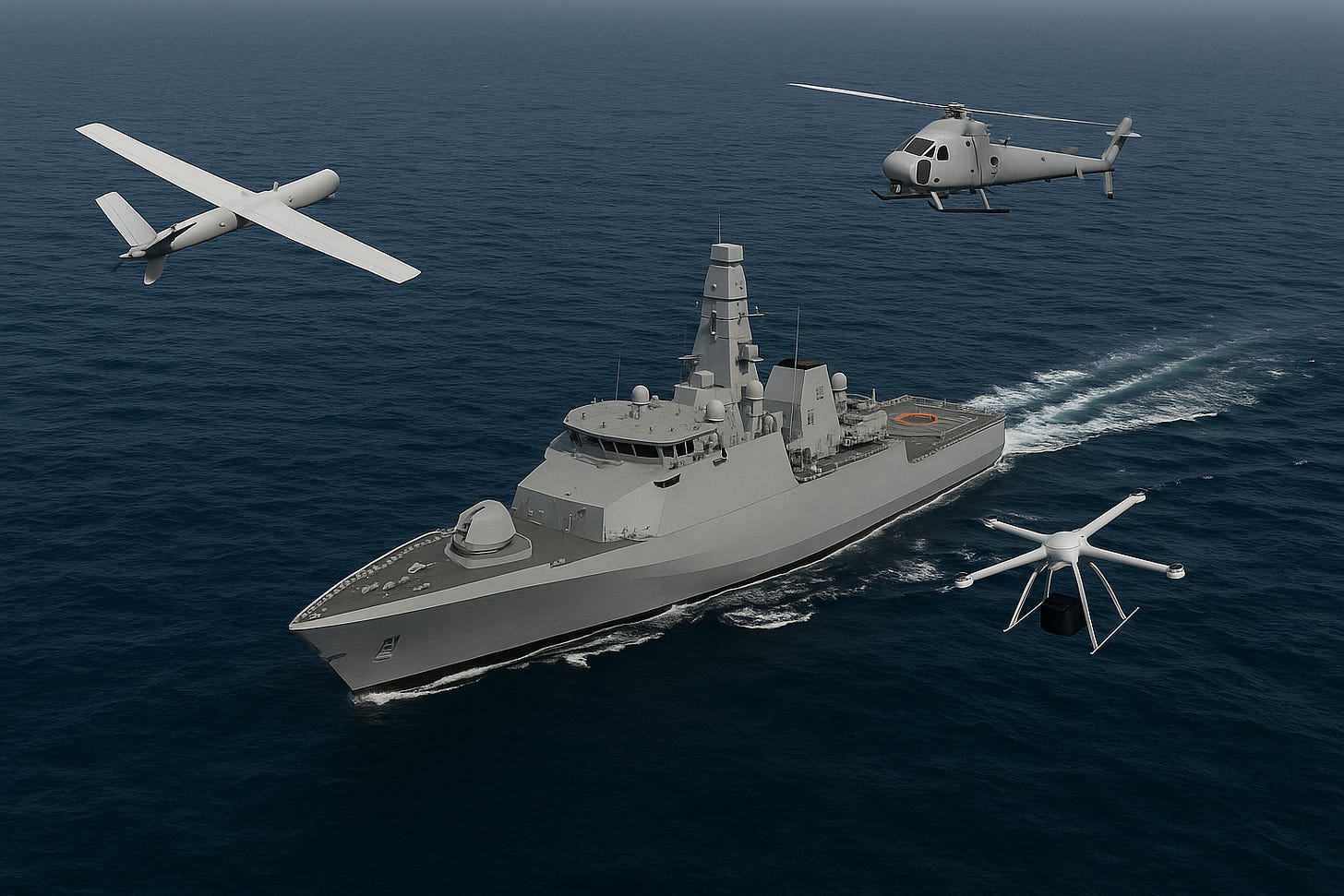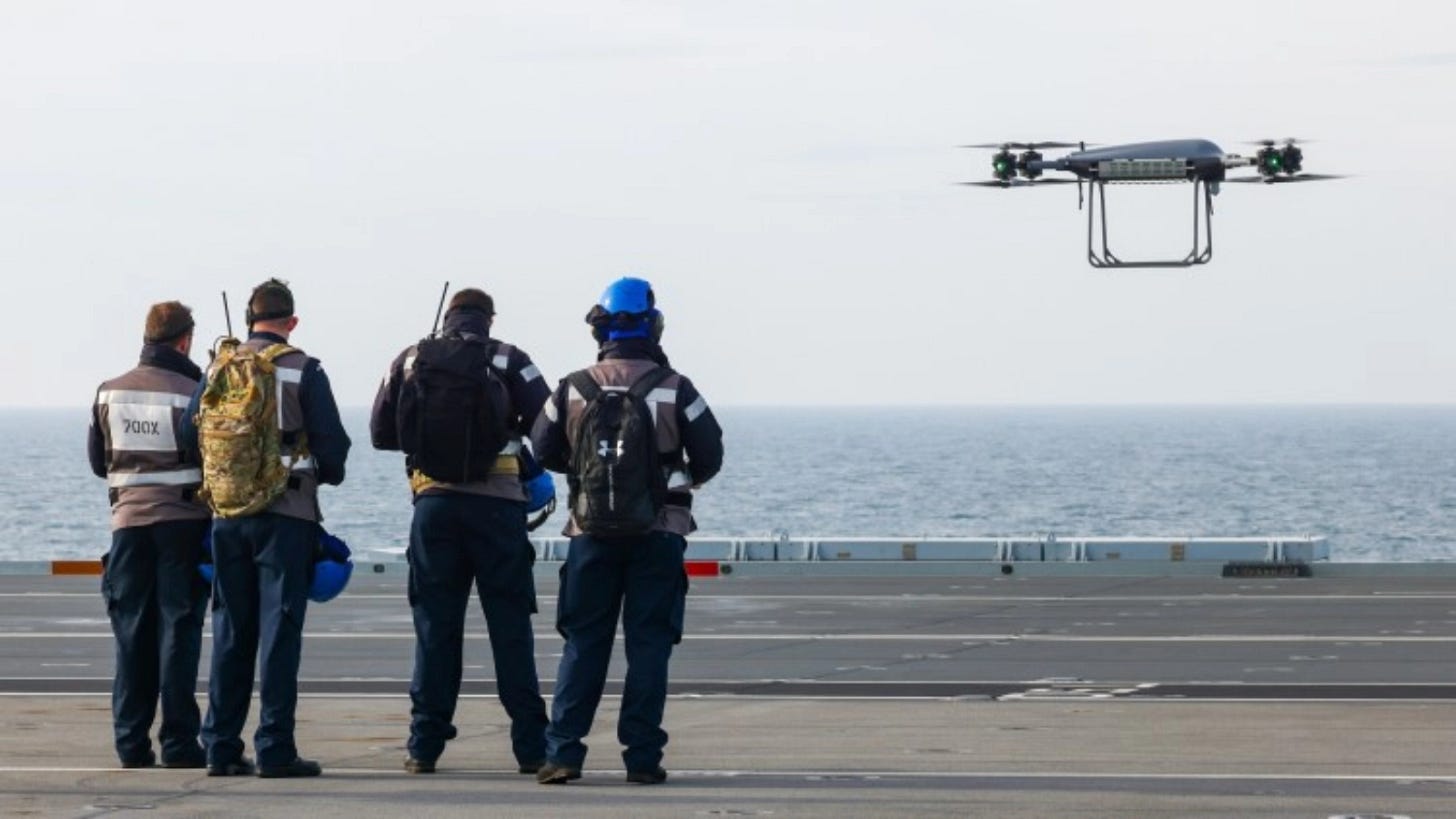Extending Operational Reach
How Drones Are Transforming the Royal Navy’s Patrol Vessels and other units
As the Royal Navy increasingly relies on forward-deployed Offshore Patrol Vessels (OPVs) to uphold UK interests worldwide, a quiet transformation is underway—driven not by new hulls or heavier weapons, but by uncrewed aerial systems (UAS) flown by a specialist unit with a distinctive mandate: 700X Naval Air Squadron.
Formed in 2018, 700X NAS is the Royal Navy’s experimental drone unit, tasked with testing, integrating, and operating airborne unmanned platforms across the Fleet. Its impact is already visible. What was once a niche capability is now proving indispensable for operations from the Caribbean to the Indo-Pacific—particularly for OPVs, which often operate independently and without embarked helicopters. These ships are now being augmented by flexible, cost-effective drone teams that extend their surveillance reach, support logistics, and enhance maritime security tasks in ways that were previously unthinkable just a few years ago.
From Hand-Launch to Flight Deck: A Tiered Capability
The core of 700X’s operational output today centres on the RQ-20 Puma AE—a rugged, hand-launched fixed-wing drone optimised for surveillance. With a range of over 30 miles and flight times exceeding two hours, Puma provides OPVs with persistent, over-the-horizon reconnaissance capabilities, day or night. It is compact, self-contained, and requires no specialist launch equipment, making it ideal for use from the stern or upper decks of patrol ships like HMS Tamar and Mersey.
In practical terms, this means a patrol ship can now investigate radar contacts or shadow suspect vessels without committing its crewed assets or putting the ship at risk. During counter-narcotics trials in UK waters and operational deployments in the Caribbean and West Africa, Puma teams from 700X have demonstrated the value of this capability, including positive visual identification of suspect craft, live video streamed to the operations room, and real-time support to boarding teams, often beyond the visual line of sight.
While Puma remains an effective tactical solution, the next step up is already in service. The Peregrine rotary-wing drone, based on the Schiebel Camcopter S-100, brings a new level of endurance, payload, and autonomy. Peregrine is a vertical take-off and landing (VTOL) platform equipped with high-definition optical sensors and, in future iterations, radar capable of detecting and tracking maritime contacts beyond the horizon.
Trials aboard HMS Lancaster in 2024 validated its ability to operate seamlessly from a warship at sea, conduct extended ISR missions, and feed data directly into the ship’s systems. Peregrine’s successful deployment during counter-narcotics patrols in the Gulf demonstrated its operational relevance and flexibility. Importantly, it also proved that a drone could augment—rather than replace—crewed rotary aviation, allowing helicopters to focus on response and interdiction. In contrast, drones take on the task of persistent surveillance.
Logistics by Drone: Closing the Last Tactical Mile
Alongside ISR, 700X has begun operational experimentation with heavy-lift multirotor drones, such as the Malloy T-150. Capable of carrying payloads up to 68 kg, these systems are, at the time of writing, embarked on the Royal Navy’s 2025 Carrier Strike Group deployment to trial ship-to-ship and ship-to-shore delivery without tying up helicopters or boats.
For OPVs operating independently, this opens the door to unmanned resupply of critical parts or humanitarian aid without port access. These drones also offer utility in disaster relief scenarios—delivering food, water, or medical supplies to inaccessible coastal locations faster and more safely than conventional methods.
Unlocking the Value of Forward-Deployed OPVs
What does this mean for OPVs stationed long-term in remote theatres?
Quite simply, uncrewed aerial systems give them eyes, reach, and agility. Puma provides an organic, on-demand surveillance layer. Peregrine adds greater range, fidelity, and the potential to integrate radar and communications relay functions. Heavy-lift drones address the logistics burden. Taken together, these systems transform the role and relevance of the OPV.
During my own time at sea, a small patrol ship often operated with minimal situational awareness beyond radar range—any aerial picture was dependent on a helicopter if one happened to be available. Today, 700X can deploy a drone team directly onto an OPV with a full suite of ISR tools, extending the ship’s awareness, improving operational safety, and significantly increasing mission effectiveness.
This isn’t theoretical. HMS Tamar, Spey, Trent, Medway and others have already deployed with 700X detachments. These platforms are no longer just showing the flag—they are actively contributing to counter-smuggling, maritime domain awareness, and regional defence partnerships with capabilities once reserved for larger vessels.
The Path Ahead: Scaling Up with Purpose
Looking forward, the Royal Navy’s investment in platforms like the Mojave STOL drone and the Proteus heavy uncrewed ASW helicopter suggests a clear trajectory: more autonomy, greater persistence, and deeper integration into the core business of the Fleet.
700X, alongside NavyX, DSTL and industry partners, is enabling that future through structured experimentation, accelerated procurement, and operational embedding. Their approach—proving systems at sea, learning fast, and deploying what works—is a model for innovation.
For OPVs, the prize is clear. By equipping even the most modestly armed ships with organic air capabilities, the Royal Navy can ensure they remain credible, connected, and capable—whatever the mission, and wherever they are deployed.
Author’s Note:
I’ve watched the evolution of 700X with great interest. Their work exemplifies what the modern Royal Navy must do well: embrace technology, experiment boldly, and turn promising tools into deployable, meaningful capability. For those of us who served before these technologies existed, it’s heartening to see what’s now possible—and what’s still to come.



